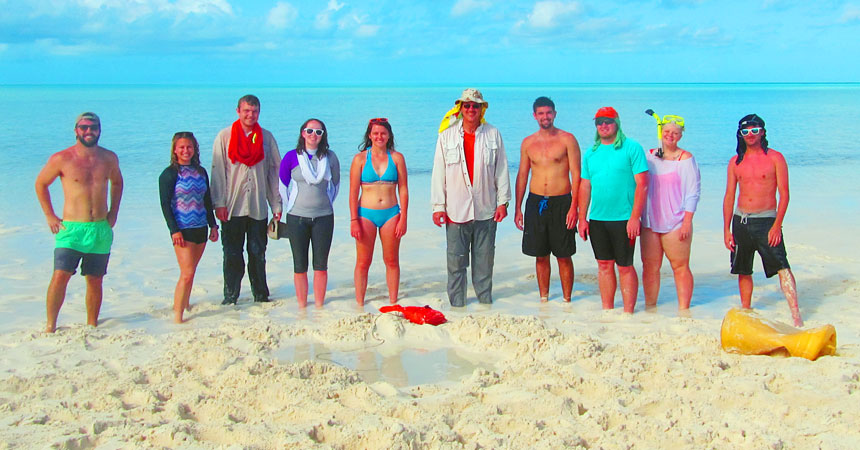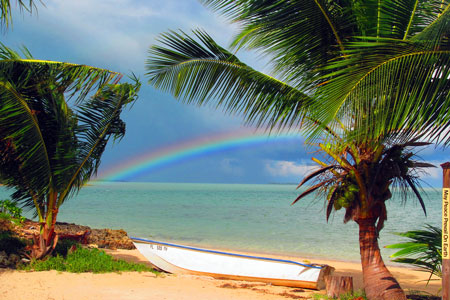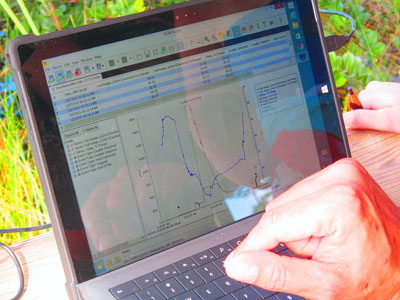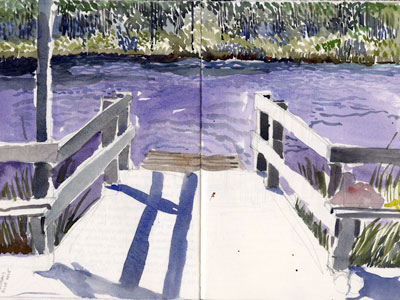Arts and Sciences? Yes, please
Tuesday, March 21, 2017

Many students working toward a science degree rarely have the opportunity to learn how to properly sketch and paint a landscape scene. But a study abroad trip to the Bahamas through the College of Arts and Sciences provides this unique opportunity.
Associate professor Liz Roth and professor Todd Halihan combined arts and sciences for the study abroad course. Students researched the hydrogeology of carbonate platforms for the science part of the class.
“Very few arts and sciences courses are actually both arts and science,” Halihan says.

Several parents of participants wondered, why the Bahamas? Halihan says it was the perfect location for students to perform their own hydrogeology research projects.
“There are very few places in the modern world where limestone actually forms, so the Bahamas is one of the few active carbonate platforms in the world,” says Halihan, a geology professor. “All on one island, you have rock being made, rock being dissolved and the water changing from salt water to freshwater, so you have all the reactions.”
The research projects led the students to several interesting parts of the islands, including a blue hole that the late Jacques Cousteau — known for his research on all water life forms — dove himself.
The art of the class included sketching and watercolors. The nature and landscape of the Bahamas provided a perfect background for students to learn.
“I was able to teach a quick class for them on how to draw,” says Roth, associate professor in the department of art, graphic design and art history. “Some of the students did really well with the drawing. At one point, we went to Fresh Creek and some of the students who weren’t eating conch were out sketching.”

“She [Liz Roth] actually taught us how to draw and there were plenty of drawing opportunities, especially for landscape,” says Cullen Pickens, graduate student in geology. “I really enjoyed the drawing aspect. It was fun to sit there and sketch and see it [the Bahamas] from that perspective.”
The course also provided a lesson in culture and hospitality.
“We snuck in quite a bit of culture,” Halihan says. “They also got to eat a bunch of food they never had in their life.”
Roth agreed the conch was great, as was the local generosity.
“The folks who work there at the field station were very informative and really assisted people to understand a bit about the unique ecological environment they have there,” Roth says.
The students also took care of the Forfar Field Station — located in North Blanket Sound, Andros Island.
“We stay at the field station, which is somewhere in between because it is not a resort paradise,” Halihan says. “It is a family island. So you’re staying in a cabin with no AC and no heat. You’re eating cafeteria style — by no means fancy. It is old school, cabin style camping. But the other thing is that the students got to see a different version of life than what you see up here.” That included being responsible for serving the food at the field station.
The students also experienced true island life, which involves importing food and other necessities.

“We ran out of coffee for a day and the reason we did is because one of the storms came by and the food barge couldn’t get in to give us food and coffee,” Pickens says. “So half of us had to go without coffee for a day.”
Because the trip took place during the holiday season, students experienced the local holiday traditions, including the annual Christmas pageant.
“They [students] got to sing in the Christmas pageant because the locals fully expected us to, so it was hard to turn them down,” Halihan says.
Pickens says the study abroad trip offered him opportunities to learn about multiple areas, not just hydrogeology.
“It was a whole new world,” he says. “We didn’t learn just hydrogeology, we learned everything from marine biology to history to culture to food. They had unique, very interesting food and the snorkeling was great. Going around and just seeing how the island works.”
The course had 10 students. Halihan and Roth are planning to continue the course next year and open it up to the broader university.
“This next fall will be a little bit different, since we are adapting it to be an introductory geology class,” says Halihan. “This will allow more students to participate.”
Halihan also has a long-term goal for the hydrogeology course.
“[Forfar Field Station] is a really good facility for geologists, and we have some of the best carbonate geologists in the world in our department,” says Halihan. “So it ties in with our research and teaching efforts. It is also home of the Bahamian Ag School that is trying to get started. It meets well with all the missions of OSU. So if we ended up with a long-term program, where we did work with College of the Bahamas and some of their programs, that would be really useful for both campuses.”
Photo Courtesy / Todd Halihan
Story by Karolyn Bolay
